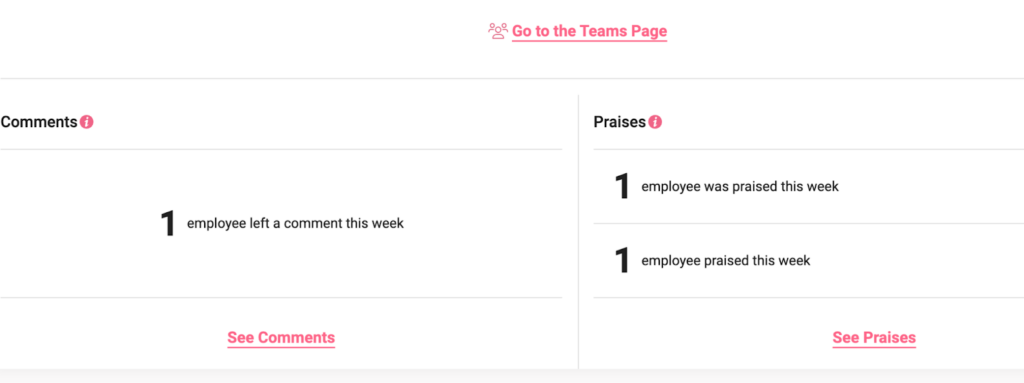How Peer-to-Peer Recognition Can Boost Organizational Performance

 8 minute read
8 minute read
Compensation, job perks, and salary increases may be enough to convey your satisfaction with your employees’ work. However, that alone won’t ensure employee retention and engagement in the long run.
People are social beings who need to feel appreciated and acknowledged. That’s why employee recognition emerges as a pivotal factor in maintaining employees satisfied and engaged.
Recognition includes feedback from not only an employer but also colleagues. Receiving praise from peers is even more powerful because they have a broader understanding of each other’s efforts and everyday challenges.
In addition to boosting employee morale, engagement, and retention, peer-to-peer recognition ultimately results in a positive impact on company profits.
What is peer-to-peer recognition?
Employee recognition involves acknowledging and appreciating employees’ efforts in the workplace.
Traditionally, this implied top-down recognition, from employers to employees. Nowadays, there are more ways to acknowledge employees’ contributions and efforts effectively, and this is known as peer-to-peer recognition or social recognition.
Peer-to-peer recognition allows colleagues to acknowledge each other’s efforts, skills, contributions, or talents. It promotes valuable, positive employee feedback and fosters teamwork and meaningful professional relationships.
Research shows that peer recognition benefits the company’s bottom line 35.7% more than manager recognition.
The reason is clear. Only colleagues fully understand all the daily challenges we face, so they can objectively notice each other’s efforts and commitment.
Benefits of peer-to-peer recognition
Creating peer-to-peer recognition or reward programs can bring many benefits to your company. It fosters a positive work environment and improves engagement, employee retention, and productivity. These all directly impact your profits.
Here are some areas where you can see the benefits of this program in your company:
#1 Increased employee engagement
Meaningful recognition has a positive impact on employee engagement.
Individuals who feel valued and appreciated by their peers are more likely to feel excited and motivated about their jobs. Research has shown that 57% of companies that introduced a peer recognition program reported an increased level of engagement.
#2 Improved company culture and employee morale
Peer-to-peer recognition helps create a positive work environment. It makes every person feel valued and appreciated. Also, it improves relationships between teammates, fosters belonging, and improves workplace culture.
Consistent social recognition nurtures employee morale. It shapes how employees feel about their place in the company and their work. One of the best ways of raising morale is by strengthening working relationships.
The peer-to-peer recognition program provides a foundation for team members to recognize each other’s efforts. In turn, the sense of togetherness increases, and employee morale improves.
#3 Enhanced productivity
Peer recognition can be a relatively minor cost to a company, yet it can deliver a significant and measurable impact on performance.
According to Gartner, peer feedback can enhance performance by as much as 14%. Another study from Harvard Business School also found that it can dramatically increase motivation and performance.
People work harder when they know their efforts are being noticed and appreciated. That’s an environment in which they want to help their team and company succeed. As this happens at individual and collective levels, achieving company objectives becomes more straightforward.
#4 Improved employee retention
Employee turnover can be highly costly, including additional recruitment, onboarding, and training expenses. Therefore, for companies, it’s one of the priorities to retain their employees and reduce turnover.
SurveyMonkey’s research shows that 63% of recognized employees are unlikely to seek other jobs. Moreover, companies that introduced peer-to-peer programs improved retention by 28% compared to those that didn’t.
Moreover, establishing a culture of recognition not only helps retain employees but also attracts top talent.
#5 Better onboarding and induction experience
When faced with a new work environment, all of us need a friendly face and a hand to pat us on the back.
New hires tend to integrate better into workplace culture if they receive positive feedback from new colleagues. Besides, timely recognition for a job well done allows for improved role modeling. Recognition inspires them to grow and find new ways to solve shared challenges.
#6 Improved cooperation and collaboration
Receiving and giving praises builds a sense of belonging, security, and acceptance. When a team member is encouraged to thank peers or leaders for their contributions, it increases the sense of shared mission and teamwork.

What’s more, peer recognition improves understanding of work, as it provides particular real-time praise for the specific outcome. For example, if your organization values health and safety metrics, peer recognition has the potential to improve safety.

#7 Empowering team leaders
More than just a “thank you” exercise, peer recognition also provides valuable insights for the manager and team leaders.
It’s a simple health check:
- When there are high levels of recognition within teams, you will know that morale and engagement are also high.
- If recognition is low, you will know there is a workforce problem, allowing you to work towards identifying and mitigating it.
Another benefit of peer recognition, as an instrument, is aiding teams to become more self-sufficient.
This tool gives employees a more significant role in improving morale on the team level. It tends to remove a sense of rigid hierarchy and increases trust between different levels of the organization
When companies encourage team members to keep their eyes open for exceptional contributions, employees quickly realize how interconnected the web of roles is.
Where recognition abounds, people are happier and more productive and stay with a company longer. As a bonus, leadership can be recognized, too. This will yield benefits both in executive motivation and the adoption of more effective leadership styles.
Peer-to-peer recognition ideas and best practices
Now that you’re aware of how peer-to-peer recognition can help you create a better workplace culture, it’s time to think about how to get started.
Technology plays a significant role in streamlining peer recognition. With different work locations and hybrid operations, the most effective employee recognition programs are commonly delivered via digital platforms.
We recommend you to do your research on the best employee experience platforms, to find the right tool that will make your peer recognition simple, effective, and fun.
Yet, we’ve collected a few ideas you could use when developing a peer-to-peer recognition program.
Use peer recognition software for timely and public recognition
With HeartCount you can easily enable employees to send public recognition anytime. Employees can easily send and receive kudos visible to everyone in the company.
All recognitions are automatically logged in the employee record, ensuring every team member’s contribution is remembered.
This also grants managers valuable insights into team dynamics over time.

Encourage participation across the company
To motivate your employees to engage in peer recognition it’s essential to make the process meaningful and enjoyable for them.
It’s not only important to provide managers with the right data, but also to include employees in the entire process of making a positive impact. To achieve this utilize software like HeartCount that is fun and makes your team feel involved.
Constantly evolve your employee recognition program
Equally important, with HeartCount, you can also provide data and insights that help continuously improve your current peer recognition program.
Track various metrics, including (but not limited to):
- the number of peer recognitions sent and received,
- the number of leaders active on the platform,
- activation rate, and
- trends in upticks or losses.
If you notice slow activity, you can react promptly and find more creative ways to encourage peer-to-peer recognition.

You can even go further and use what you collected with HeartCount to discover valuable correlations between recognition and critical business metrics, such as employee satisfaction and retention.

Get started with peer-to-peer recognition
As 78% of employees report that being recognized motivates them in their job, you shouldn’t miss the opportunity to use this “easy to implement” strategy in your workplace.
Considering the positive changes it can bring to your organization and the effort, time, and money you will invest in a peer-to-peer recognition program, it is not just a nice thing to have; it is a necessity.
Plus, modern technology is on your side, offering streamlined and effective employee recognition platforms. If you need personalized guidance on how to integrate peer-to-peer recognition in your organization, contact our team!